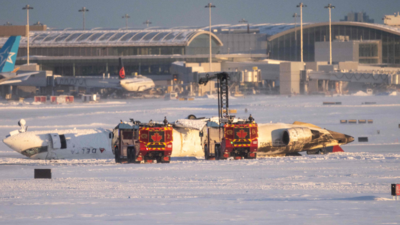A Delta Air Lines jet trying to land at Toronto Pearson Airport, Canada, in strong winds and snow crashed and flipped over on the Monday afternoon (local time). The plane came to rest upside down with at least one wing missing. All 80 people on board Flight 4819 from Minneapolis were evacuated.
Photos and videos showed passengers using the plane’s front and rear doors to exit and walking on the snow-covered tarmac while firefighters sprayed water on the aircraft.
Poll
What’s the Most Important Factor in Ensuring Flight Safety?
What happened?
Delta Flight 4819 crashed while landing on a snow-covered runway in Toronto around 3:30 pm Eastern time on Monday after departing from Minneapolis, US state of Minnesota.
The jet, a Bombardier CRJ-900, flipped upside down on the runway.
“We are very grateful there was no loss of life and relatively minor injuries,” Deborah Flint, CEO of Greater Toronto Airports Authority, said while talking to reporters.
CNN obtained audio from air traffic control between the controller and the pilot of a nearby Medevac flight.
“LifeFlight 1, Medevac, just so you are aware, there are people outside walking around the aircraft there,” the controller said.
“Yeah, we’ve got it,” the Medevac pilot responded. “The aircraft is upside down and burning.”
Also read: Passengers recount Delta jet crash in Toronto
How did this happen?
The cause of the crash is not yet known, and the Transportation Safety Board of Canada will lead the investigation.
Airport fire chief Todd Aitken said it wasn’t appropriate to comment on the investigation into the crash at Toronto Pearson Airport, he did give an update on the conditions of the runway, CNN reported. “What we can say is the runway was dry and there was no cross-wind conditions,” Aitken said.
Experts say the weather, especially the wind speeds, may have played a role. The region experienced a snowstorm that brought more than eight inches of snow over the weekend. On Monday, the high temperature was 20F, and wind gusts reached 38 mph, according to The New York Times.
According to the Meteorological Service of Canada, the airport was experiencing blowing snow and winds of 32 mph (51 kph) gusting to 40 mph (65 kph). The temperature was about 16.5 degrees Fahrenheit (minus 8.6 degrees Celsius).
Bombardier CRJ-900s are built to handle crosswinds of 35 knots, aviation expert Schirard told CNN. The plane was hit by crosswinds at a 45-degree angle, estimated at 23 to 24 knots, he said.
‘Aircraft is upside down and burning’
The aircraft stopped at the intersection of Runways 23 and 15L, close to the beginning of the runway. Shortly after the crash, tower controllers communicated with the crew of a medical helicopter that had recently departed from Pearson but was returning to assist.
“Just so you’re aware, there are people outside walking around the aircraft,” a controller informed.
“Yeah, we’ve got it. The aircraft is upside down and burning,” the medical helicopter pilot replied.
Also read: Video captures passengers walking on ceiling to escape Delta jet that crashed in Canada
Who was injured?
All 80 people on board—76 passengers and four crew members—were evacuated, the Federal Aviation Administration said. However, 17 people were reportedly injured. Video showed passengers and crew leaving the upside-down plane through the emergency exit as smoke rose from the aircraft.
Eighteen passengers were taken to nearby hospitals, Pearson Airport fire chief Todd Aitken confirmed Monday night.
“At this time, we do not know of any of those passengers having critical injuries,” Pearson CEO Deborah Flint said on Monday evening after initially reporting 17 injured.
Medical transport company Ornge reported three people with critical injuries: a man in his 60s, a woman in her 40s, and a child. Their identities have not been released.
On Monday evening, the city’s SickKids hospital said the child was in good condition but did not provide further details.
The aircraft
Endeavor Air, headquartered in Minneapolis, is a subsidiary of Delta Air Lines and the largest operator of CRJ-900 aircraft globally. According to its website, the airline has a fleet of 130 regional jets and operates 700 flights daily to more than 126 cities across the US, Canada, and the Caribbean.
The CRJ-900, a regional jet developed by Canadian aerospace company Bombardier, belongs to the same aircraft family as the CRJ-700, which was involved in the midair collision near Reagan National Airport on January 29.
One wing missing
John Cox, CEO of aviation safety consulting firm Safety Operating Systems in St Petersburg, Florida said one key question is why the plane was missing its right wing.
“If one wing is missing, it’s going to have a tendency to roll over,” he was quoted as saying by news agency Associated Press. “Investigators will focus on what happened to the wing, as well as the flight data recorder and cockpit voice recorder. These will be recovered soon, and once analyzed by the Transportation Safety Board of Canada, they will provide a clear understanding of what took place.”







